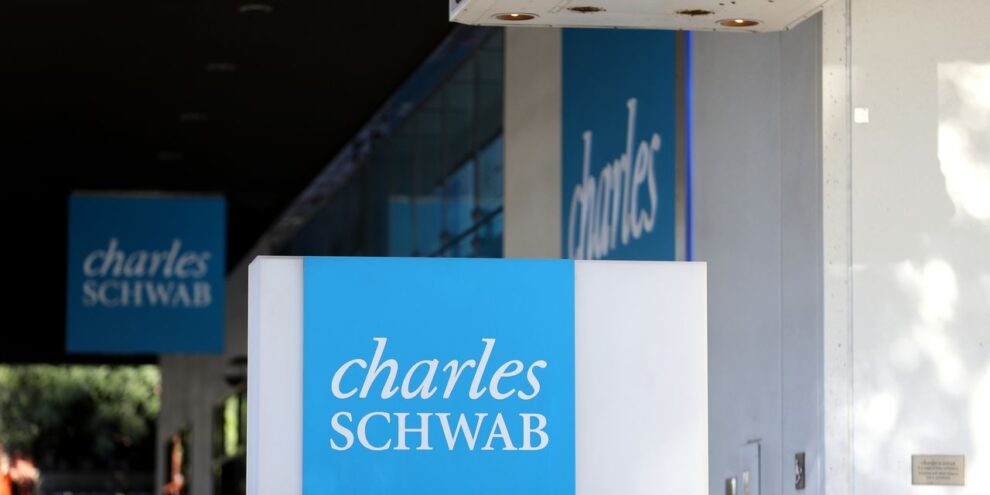
Charles Schwab Corp. is well-known as the premier discount broker in the U.S., and some may not realize that it’s actually a savings and loan holding company.
Schwab’s SCHW, -9.00% main banking subsidiary is Charles Schwab Bank SSB, an insured depository institution based in Westlake, Texas. The bank had $349 billion in total assets as of Dec. 31, while Charles Schwab Corp. had $552 billion in total assets.
On Monday, Charles Schwab Corp. issued a press release in which it said it had “an estimated $100 billion of cash flow from cash on hand, portfolio-related cash flows, and net new assets we anticipate realizing over the next twelve months.” The company also said it had access to “over $300 billion of incremental [borrowing] capacity with the Federal Home Loan Bank (FHLB) and other short-term facilities—including the recently announced Bank Term Funding Program (BTFP).”
As part of its report of “monthly activity highlights,” the above comments in Schwab’s press release seemed designed to calm fears over its liquidity, in the wake of two bank failures. Schwab’s stock was down 19% at 10:40 a.m. ET on Monday, following a 24% decline the previous week.
An outflow of deposits drove the sale of securities that SVB Financial Group SIVB, announced last week, before that company’s main subsidiary Silicon Valley Bank of Santa Clara, Calif., was closed by state regulators on Friday and handed over to the Federal Deposit Insurance Corp. SVB’s problems sprang from its focus on clients in the venture capital industry and a balance sheet heavily concentrated in long-term bonds that had lost value as interest rates rose. Being forced to sell bonds at a loss — after rising interest rates had pushed bonds’ market values lower — helped lead to the bank’s failure.
Signature Bank SBNY, -22.87% of New York failed on Sunday. This bank, despite having a diversified business model, suffered a rapid outflow of deposits in the wake of trouble among virtual currency exchanges that were among its clients.
Schwab’s business model
One reason investors might be so worried about Schwab is how reliant the company is on its main banking subsidiary. Schwab’s net income for 2022 totaled $7.18 billion. Net income for Charles Schwab Bank SSB totaled $3.15 billion.
On the holding company level, Schwab’s net revenue for 2022 totaled $15.57 billion. Here’s how that was broken down:
- Net interest revenue: $7.819 billion
- Asset management and administration fees: $3.049 billion
- Trading revenue $3.191 billion
- Bank deposit account fees: $916 million
- Other: $605 million
Charles Schwab Bank SSB’s net interest income totaled $6.666 billion during 2022.
So the company’s banking business is critically important. Brokerage clients’ cash is kept in bank sweep accounts, and clients who use margin to invest pay fees and interest on borrowings.
Schwab pointed out in its press release that its ratio of loans to deposits was a low 10% and said all of its loans were secured by residences or securities.
There’s no credit problem at Schwab: Loans made up only 7.3% of its total assets as of Dec. 31. And nonperforming loans made up only 0.06% of net loans. Loan losses were very low during 2022, with a 0.01% of net charge-offs to average loans.
Looking more closely at Schwab’s main banking subsidiary, accumulated other comprehensive income (AOCI), which included unrealized losses on available-for-sale securities, totaled -$19.68 billion as of Dec. 31. That amount was subtracted from the bank’s total equity capital, which was $7.664 billion as of Dec. 31.
The bank was considered “well capitalized” under regulatory guidelines as of Dec. 31. This is broken down on page 118 of Schwab’s annual report.
Despite having such a high negative number for AOCI as of Dec. 31, it appears the bank would not need to sell securities at a loss, even if it needed to raise cash to meet deposit outflows, now that federal regulators have said they would accept securities as collateral at par (or face value) for borrowings through the new emergency lending facility.











Add Comment